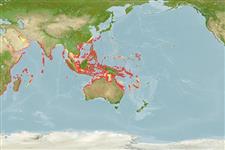Teleostei (teleosts) >
Kurtiformes (Nurseryfishes, cardinalfishes.) >
Apogonidae (Cardinalfishes) > Apogoninae
Etymology: More on author: Lacepède.
Environment: milieu / climate zone / depth range / distribution range
Ecology
Marine; reef-associated; depth range 1 - 40 m (Ref. 9710). Tropical; 30°N - 30°S
Indo-West Pacific: Red Sea and East Africa to Papua New Guinea, north to Miyakejima, Japan (Ref. 559), south to Australia and New Caledonia (Ref. 2142).
Size / Weight / Age
Maturity: Lm ? range ? - ? cm
Max length : 14.5 cm TL male/unsexed; (Ref. 11441)
Dorsal
spines
(total): 8;
Dorsal
soft rays
(total): 9;
Anal
spines: 2;
Anal
soft rays: 8;
Vertebrae: 14. Distinguished by having the following characteristics: Dorsal-fin rays VII-I, 9; anal-fin rays II,8; pectoral-fin rays 14; pelvic-fin rays I,5; pored lateral line scales 25; predorsal scales 5; circumpeduncular scales 12; total gill rakers 24, developed gill rakers, 21; without oblique dark bars on cheek (Ref. 93839). Color in life coppery with iridescence, paler posteriorly; a blackish stripe, bordered by a blue line, running from front of snout through eye and beyond; a narrow blue streak on maxilla. Large and oblique mouth; median predorsal scales 5; preopercular ridge smooth with posterior and most of ventral margin serrate. Black bar encircling caudal peduncle present in both young and adult phases (Ref. 02142).
Inhabits holes in rocks or under ledges in shallow waters. Known to occur in mixed aggregates with Apogon apogonoides during summer and autumn, but form separate aggregates in winter and spring (Ref. 559 and 637). Forms aggregations (Ref 90102).
Life cycle and mating behavior
Maturity | Reproduction | Spawning | Eggs | Fecundity | Larvae
Mouthbrooders (Ref. 240). Distinct pairing during courtship and spawning (Ref. 205).
Randall, J.E., T.H. Fraser and E.A. Lachner, 1990. On the validity of the Indo-Pacific cardinalfishes Apogon aureus (Lacepède) and A. fleurieu (Lacepède), with description of a related new species from the Red Sea. Proc. Biol. Soc. Wash. 103(1):39-62. (Ref. 2142)
IUCN Red List Status (Ref. 130435)
Threat to humans
Harmless
Human uses
Fisheries: minor commercial; aquarium: commercial
More information
ReferencesAquacultureAquaculture profileStrainsGeneticsElectrophoresesHeritabilityDiseasesProcessingNutrientsMass conversion
Tools
Special reports
Download XML
Internet sources
Estimates based on models
Preferred temperature (Ref.
123201): 24.7 - 29, mean 27.5 °C (based on 804 cells).
Phylogenetic diversity index (Ref.
82804): PD
50 = 0.5000 [Uniqueness, from 0.5 = low to 2.0 = high].
Bayesian length-weight: a=0.01148 (0.00705 - 0.01869), b=3.16 (3.03 - 3.29), in cm total length, based on LWR estimates for this species & Genus-body shape (Ref.
93245).
Trophic level (Ref.
69278): 3.6 ±0.54 se; based on food items.
Resilience (Ref.
120179): High, minimum population doubling time less than 15 months (Preliminary K or Fecundity.).
Fishing Vulnerability (Ref.
59153): Low vulnerability (10 of 100).
Nutrients (Ref.
124155): Calcium = 105 [54, 166] mg/100g; Iron = 0.815 [0.484, 1.351] mg/100g; Protein = 18.7 [17.5, 19.8] %; Omega3 = 0.127 [0.076, 0.203] g/100g; Selenium = 31.4 [17.4, 58.6] μg/100g; VitaminA = 59.1 [17.6, 192.7] μg/100g; Zinc = 1.42 [0.95, 2.04] mg/100g (wet weight);
